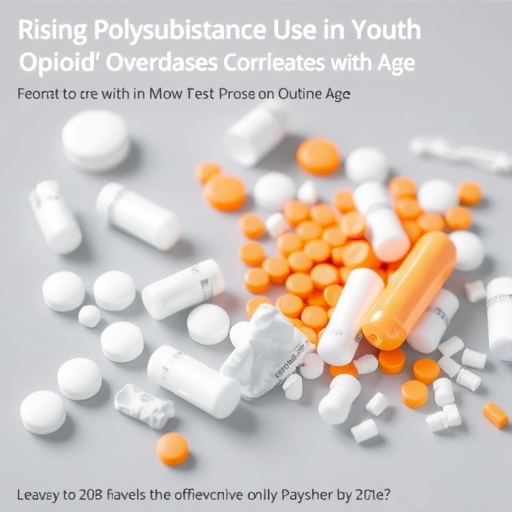In recent years, the United States has witnessed a disturbing evolution in the opioid overdose crisis, particularly among younger populations. While previous research has largely focused on adults aged 25 to 54 as the primary victims of opioid overdoses involving multiple substances, a groundbreaking study led by Boston University School of Public Health (BUSPH) in collaboration with Mass General Brigham for Children reveals a critical shift. New evidence now shows that polysubstance-involved opioid overdoses — overdoses where opioids are combined with other drugs — are alarmingly prevalent among youth aged 15 to 24. This revelation signals a disturbing expansion of the opioid epidemic’s reach into the younger demographic, amplifying the urgency for tailored prevention and treatment strategies.
Published recently in the esteemed medical journal Pediatrics, this extensive observational study analyzed federal overdose mortality data from 2020 through 2023. The findings expose a sobering trend: starting as early as age 15, polysubstance opioid overdoses have increased steadily with age among youth, surpassing opioid-only overdoses from age 21 onward. A startling 93% of these fatal overdoses involved fentanyl or other synthetic opioids, underscoring the deadly potency of the modern drug supply. In parallel, stimulants such as methamphetamine and cocaine consistently emerged as predominant contributors within these polysubstance events, highlighting a toxic convergence of substances driving youth mortality.
Historically, opioid overdose waves in the United States have unfolded in distinct phases. The 1990s witnessed the initial surge fueled primarily by prescription opioids. This was followed by a heroin-driven crisis around 2010, and more recently, a fentanyl and synthetic opioid-centered wave beginning in 2013. The current fourth wave, as described by the study’s lead author Connor Buchholz, a doctoral candidate in health services and policy research at BUSPH, is characterized by the lethal combination of synthetic opioids and stimulants. This new phase reflects an intersection of pharmacological hazards, where youth are increasingly exposed to unpredictable drug mixtures that exacerbate overdose risk.
The scale of this crisis among youth is staggering. The study reports nearly 23,000 opioid overdose fatalities in individuals aged 15 to 24 between 2020 and 2023. Approximately half of these deaths involved polysubstance use, with stimulants playing a central role in 65% of polysubstance opioid overdose deaths and 33% of all opioid overdose deaths in this age group. These statistics starkly illustrate that youth overdose mortality cannot be understood or addressed solely through the lens of opioids, but must incorporate the vital context of co-occurring stimulant use.
Age stratification within the study further reveals a progressive rise in polysubstance involvement with advancing youth age. Polysubstance opioid overdose deaths constituted 25% of fatalities among 15-year-olds, escalating to 40% among 18-year-olds, 53% in 21-year-olds, and peaking at 58% among 24-year-olds. Similarly, stimulant involvement grew from 12% in the youngest bracket to 41% among the oldest youth studied. This age-linked trajectory implies complex behavioral and environmental factors, possibly related to drug availability and evolving patterns of use, intensifying the overdose risk as adolescents transition into early adulthood.
The study refrains from explicitly dissecting all causal factors behind this age-related increase but points to several plausible drivers. Chief among these are the expanding availability of illicit and highly potent synthetic substances in the drug market, which heightens the risk of unintended exposure. Equally significant is the rise in mental health challenges among youth, including increasing diagnoses of attention-deficit/hyperactivity disorder (ADHD) and other psychological conditions that may compel some to self-medicate through substance use. These converging elements likely catalyze the shift towards polysubstance consumption patterns, complicating prevention efforts.
The contamination of counterfeit pills with fentanyl compounds the dangers for youth, even as opioid prescriptions have decreased. Pills masquerading as legitimate prescription medications—such as oxycodone or benzodiazepines—pose an insidious threat because they often contain lethal doses of synthetic opioids without the user’s knowledge. This covert presence of fentanyl in the drug supply underscores the need for heightened drug education, harm reduction approaches, and broader access to overdose reversal interventions tailored specifically for youth populations.
Adding to the challenge, recent federal policy decisions threaten to exacerbate this public health emergency. The study highlights concerns regarding impending cuts to Medicaid funding, a primary source of medical coverage for youth struggling with opioid use disorder (OUD). Such budget reductions risk restricting access to evidence-based medications for OUD, including buprenorphine, methadone, and naltrexone, which have proven efficacy in mitigating overdose risk. Moreover, reduced funding may limit the availability of naloxone (commonly known by the brand name Narcan) distribution programs, critical life-saving tools for first responders and communities grappling with opioid crises.
Dr. Scott Hadland, chief of the Division of Adolescent and Young Adult Medicine at Mass General Brigham for Children and senior author of the study, underscores the necessity of early, developmentally appropriate intervention. He notes that youth and their families depend heavily on Medicaid-supported treatments, and that timely access to comprehensive care can significantly alter the trajectory of opioid addiction and overdose risk. Hadland also warns that budgetary constraints threaten the ongoing progress made in combatting opioid fatalities among young people.
In response to these emerging realities, clinicians are urged to embrace holistic, nonstigmatizing approaches tailored to the unique needs of youth with OUD and stimulant use disorders (StUD). Dr. Buchholz emphasizes adherence to evolving clinical practice guidelines from leading U.S. medical organizations that advocate for integrated treatment modalities. These include both pharmacological options and behavioral interventions, underscoring that addressing polysubstance overdose risk requires multifaceted strategies.
Education remains a cornerstone of effective intervention, particularly regarding overdose prevention measures like naloxone administration. The study advocates expanding comprehensive training for healthcare providers who work with at-risk youth, enabling them to deliver life-saving overdose reversal techniques promptly and competently. For stimulant-related disorders, where FDA-approved pharmacotherapies are limited, the use of off-label medications alongside contingency management and behavioral therapies offers promising avenues, although continued research is essential.
Ultimately, this study serves as a critical wake-up call: the opioid crisis among American youth is no longer a single-substance epidemic but a complex polysubstance emergency that demands urgent, innovative responses. Understanding the nuanced role that synthetic opioids and stimulants play in this evolving landscape is vital to developing strategies that save lives. As the epidemic enters this perilous fourth wave, public health officials, clinicians, policymakers, and communities must collaborate on comprehensive, youth-centered solutions to reverse the tide of overdose deaths.
Subject of Research: People
Article Title: Polysubstance-Involved Opioid Overdose Deaths Among US Youths: 2020 to 2023
News Publication Date: August 25, 2025
Web References:
https://pubmed.ncbi.nlm.nih.gov/37705148/
https://publications.aap.org/pediatrics/article-abstract/156/2/e2024070433/202428/Polysubstance-Involved-Opioid-Overdose-Deaths?redirectedFrom=fulltext%23
https://www.cdc.gov/overdose-prevention/about/understanding-the-opioid-overdose-epidemic.html
https://www.samhsa.gov/data/sites/default/files/NSDUH%25202023%2520Annual%2520Release/2023-nsduh-main-highlights.pdf
Recent Trends in Mental Health and Substance Use Concerns Among Adolescents
https://www.cdc.gov/nchs/nvss/vsrr/drug-overdose-data.htm
https://www.pbs.org/newshour/nation/60-years-after-medicaid-was-signed-into-law-trumps-one-big-beautiful-bill-is-chiseling-it-back
https://www.massgeneral.org/doctors/22683/scott-hadland
https://www.healthaffairs.org/content/forefront/proposed-budget-cuts-narcan-programs-dangerously-misunderstand-public-health-aims
https://journals.lww.com/journaladdictionmedicine/fulltext/2024/05001/the_asam_aaap_clinical_practice_guideline_on_the.1.aspx
References: 10.1542/peds.2024-070433
Keywords: Stimulants, Drug addiction, Narcotics addiction, Substance related disorders, Opioid addiction, Children, Adolescents, Substance abuse, Drug abuse, Illicit drugs, Cocaine, Heroin, Public health, Insurance
Tags: collaboration in youth health researchcomprehensive addiction treatment approachesdual drug use among young populationsfentanyl-related overdose statisticsnational overdose mortality data analysisopioid epidemic in young adultspolysubstance use in adolescentsprevention strategies for youth substance usepublic health response to opioid crisisrising overdose rates among teenagerssynthetic opioids impact on youthyouth opioid overdose trends





